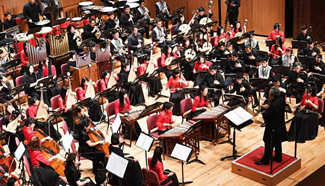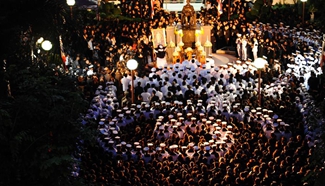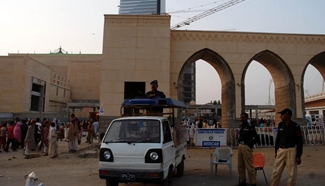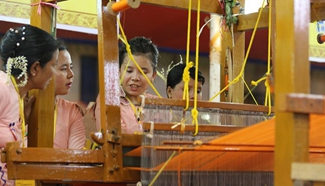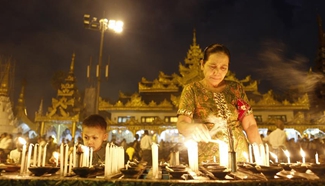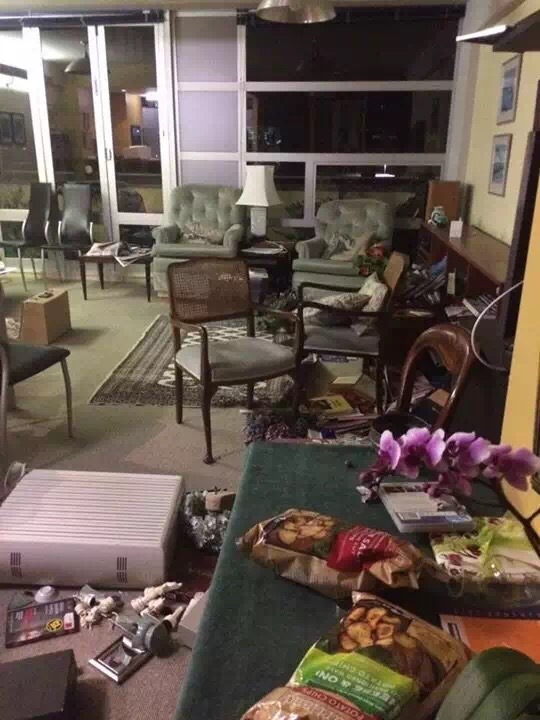
Photo taken on Nov. 14, 2016 (local time) shows a living room of a house in Wellington, New Zealand. A major earthquake rocked South Island of New Zealand in the wee hours of Monday, followed by a series of strong aftershocks and a tsunami warning. (Xinhua)
WELLINGTON, Nov. 14 (Xinhua) -- Emergency services were trying to reopen communications and transport to the tourist town of Kaikoura after a deadly earthquake rocked much of New Zealand early Monday.
Roads into Kaikoura, on the northeast coast of the South Island, were blocked by landslides after the 7.5-magnitude quake hit just after midnight.
Police confirmed the two deaths, saying emergency services were still working at the scenes.
One fatality occurred at a property at Mount Lyford, north of Christchurch, on the east of the South Island, and the other at a reported collapsed property in Kaikoura.
Medical rescue helicopters and the air force planes were flying into Kaikoura, a popular tourist destination famed for its coastal scenery and whale-watching activities.
The New Zealand Defence Force (NZDF) said it had mobilized at least three of its aircraft to support the government's response to the severe quake.
Air Commodore Darryn Webb said an air force NH90 helicopter was supporting relief efforts and a P-3K2 Orion surveillance aircraft was surveying main transport routes and towns from Picton, on the top of the South Island, to the second city of Christchurch.
Another NH90 helicopter and other aircraft were on standby for other tasks, including conducting an aerial survey of areas in the Kaikoura region, which suffered the brunt of the earthquake, Webb said in a statement.
A New Zealand Police spokesperson told Xinhua that emergency services had no information on how many, if any, overseas travellers were in Kaikoura when the quake struck.
"We don't have any information on specific individuals/groups who are in Kaikoura, but can confirm that Kaikoura is currently not accessible by road - so everyone there is stuck - locals and tourists alike," the spokesperson said.
"Government agencies are working together to provide support to people affected by the quake, including those in Kaikoura."
Prime Minister John Key and Acting Civil Defence Minister Gerry Brownlee said it was impossible to rule out further fatalities.
"On the very best information we have at the moment, we think it's only likely to be two, but of course there are isolated parts of the country in which we don't have perfect eyes on so we can't be 100 percent sure, but we're not aware of any that we're not reporting," said Key.
"We don't have any indications at this point to believe that will rise, but we obviously can't rule that out because what's going to happen now as we have daylight is we can do a proper assessment. Communities will obviously go out and reach out to their neighbors and their friends and their workmates to get a sense of the damage and making sure people get support."
Structural engineers were also checking buildings in the capital, Wellington, where the quake was felt strongly.
The quake was centered 15 km northeast of Culverden, on the east of the South Island, and struck at 12:02 a.m. on Monday, according to the government's GeoNet monitoring service.
The quake was 15 km deep and was felt widely throughout New Zealand.
It is being followed by many aftershocks, the largest of them a magnitude of 6.2.
The Ministry of Civil Defence and Emergency Management (MCDEM) issued a tsunami warning along most of the country's eastern coasts after the initial earthquake and urged residents to move to higher ground.
The first tsunami waves had arrived, but it was too early to know what damage or casualties there might have been, said a statement from the MCDEM.
"Further waves should be expected and may be larger or more dangerous," it said.
The tsunami warning was later downgraded to a marine and beach threat, but the MCDEM still urged people to stay off beaches, stay out of the water, and not go sightseeing.
New Zealand is frequently rattled by earthquakes, most of which do no damage and cause no injuries, but Monday's quake brought back memories of the 6.3-magnitude quake which killed 185 people in Christchurch in February 2011.





